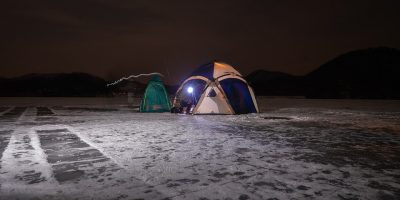Offshore fishing is fun since it gives you better access to various depths. But before you hop into your boat, make sure that you’re wearing a lightweight life vest for fishing. This is a must regardless if you’re a good swimmer or a long-time angler. You’ll never know when tragedy will strike. Life jackets will be your lifeline with added convenience as it also serves as a fishing pack.
| LIFE JACKET | BRAND | EXPERT RATING | CHECK PRICE |
|---|---|---|---|
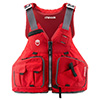 | Our Top Pick! NRS Chinook Fishing Life Jacket | Check Price | |
 | NRS cVest Mesh Back Floatation Device | Check Price | |
 | Onyx Kayak Fishing Life Jacket | Check Price |
You were wearing life jackets while offshore fishing is like wearing a seatbelt. It doesn’t matter if you’re driving for the first time or a decade. You still buckle up because it will save your life in case accidents occur. This is the very concept of life jackets. It’s something you need to wear while being careful not to need it at the same time.
If you’re looking for a fishing life vest, I reviewed here three of my top picks. I’ve been using these three life jackets on my fishing trips, and I swear by their quality and floatation efficiency. I once got swept by sudden currents while kayak fishing, and one of these vests really saved my life.
Why you need to wear a life jacket while fishing
- It’s a lifesaver. I can’t stress this enough: life jackets save lives. You wouldn’t want to wait until you’re sinking into the water and hating yourself for not wearing one. Sudden currents happen, especially if you’re not 100% familiar with the dynamics of the water where you’re fishing.
- Casting can go wrong. One of the difficult aspects of learning how to fish is casting a line. The motion and power it takes may put you out of balance. This will send you into the water. A life jacket will make you float, especially if you’re not the best swimmer.
- The cold water is your enemy. Aside from being a floatation device, many life jackets for fishing also provide added warmth. This will reduce your risk of succumbing to hypothermia in case you fall into freezing waters.
- It’s convenient. Life jackets designed for fishing have multiple pockets in front. This keeps small tackle like hooks, baits, and lures handy. There’s no need to rummage all over your boat just to find the tackle you need.
- The authorities require it. Many fishing reservoirs require an angler to wear an approved life jacket once they are fishing offshore. This is a safety protocol to prevent accidents and deaths.
Lightweight Life Vest For Fishing – Our Top 5 Picks!
OUR #1 CHOICE
OUR TOP PICK: NRS Chinook Fishing Life Jacket
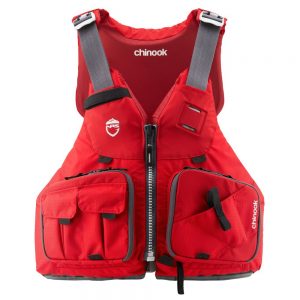
Product Name: NRS Chinook Fishing Life Jacket
Product Description: If you’re looking for a lightweight life vest for fishing, you should consider the NRS Chinook Fishing Life Jacket. This floatation device carries the Coast Guard Certification awarded through the Underwriters Laboratories (UL). To start, this life jacket has PlushFIT foam that conforms all over the body. It’s soft and bears excellent buoyancy. It’s also designed to have a lot of room in front without impeding your arm movements. In front, this life vest has two large zippered pockets where you can keep small fishing tools. You can also utilize the two other accessory pockets and one tool holder. This life jacket isn’t just a lifesaver; it’s also a powerhouse vest for prolific anglers.
Offer price: $$$
Availability: InStock
-
Buoyancy
-
Storage
-
Fit and Comfort
-
USCG Certification
-
Value for Money
Overall
Summary
Moreover, this has adjustable straps at the back and along the shoulders to achieve the best fit. It also has multiple exterior attachment points where you can hook additional accessories and small equipment.
Another thing that I really like about this vest is the built-in rod holder. You can secure your rod in the vest while you work on other things on the boat.
For added safety, this vest has reflective accents, in case you’re fishing in low-light conditions.
Pros
Coast Guard Certified
PlushFIT foam
Multiple pocket and attachment points
Cons
I wish they have wider size options
RUNNERS-UP
NRS cVest Mesh Back Floatation Device
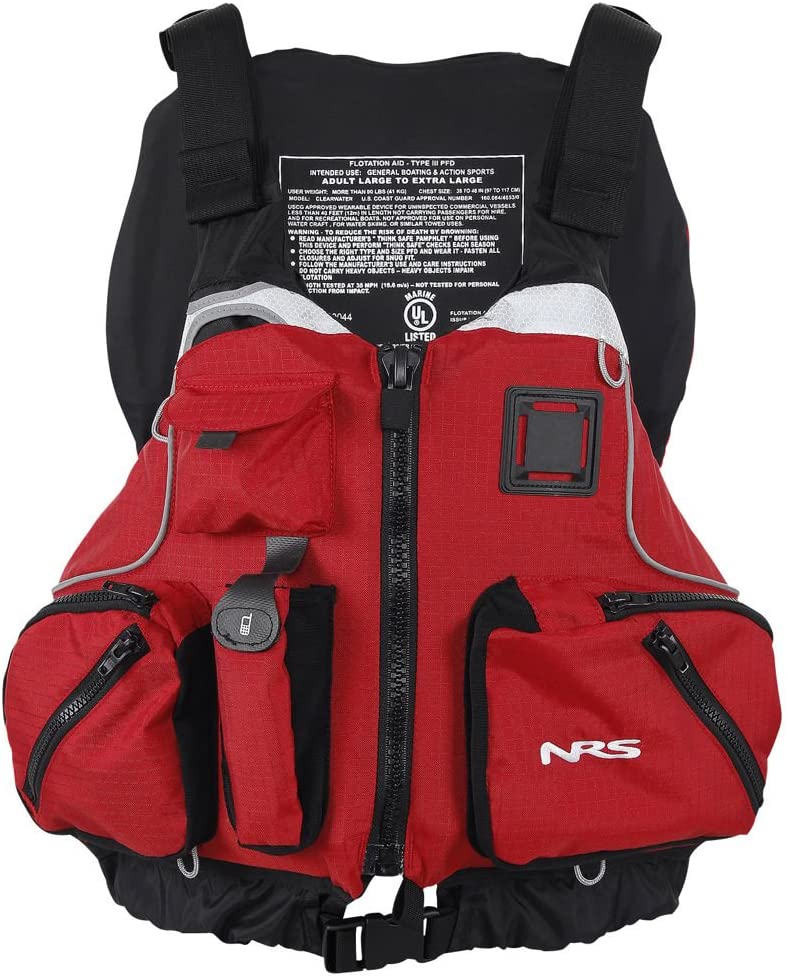
Another NRS vest I have is the cVest. I use this on hotter days since it has a mesh back that keeps my skin cool even on long fishing trips. This one is made for kayaking with a US Coast Guard Type III certification. It has a medium profile and considerably lightweight.
Moreover, this is designed for touring, so it has high-back floatation foam. This is compatible with most sea kayak seats without feeling bulky or in the way.
Aside from that, this NRS vest is equipped with plenty of storage options. It has two lash tabs, multiple D rings, two small clamshell pockets, and two large zippered pockets. It’s similar to the NRS Chinook, and it’s customizable with six adjustment points.
Overall, this life jacket is made of 400-denier ripstop nylon. It resists tears and abrasions, even on the most action-packed fishing trips.
Also, I like that it has reflective accents for added visibility. It’s also available in bright lime color if you’re worried about not being seen on the water.
This is a fantastic life jacket with surprising comfort. However, if you’re thinking of stashing a beer can here, it just won’t work. Trust me, I tried.
Onyx Kayak Fishing Life Jacket
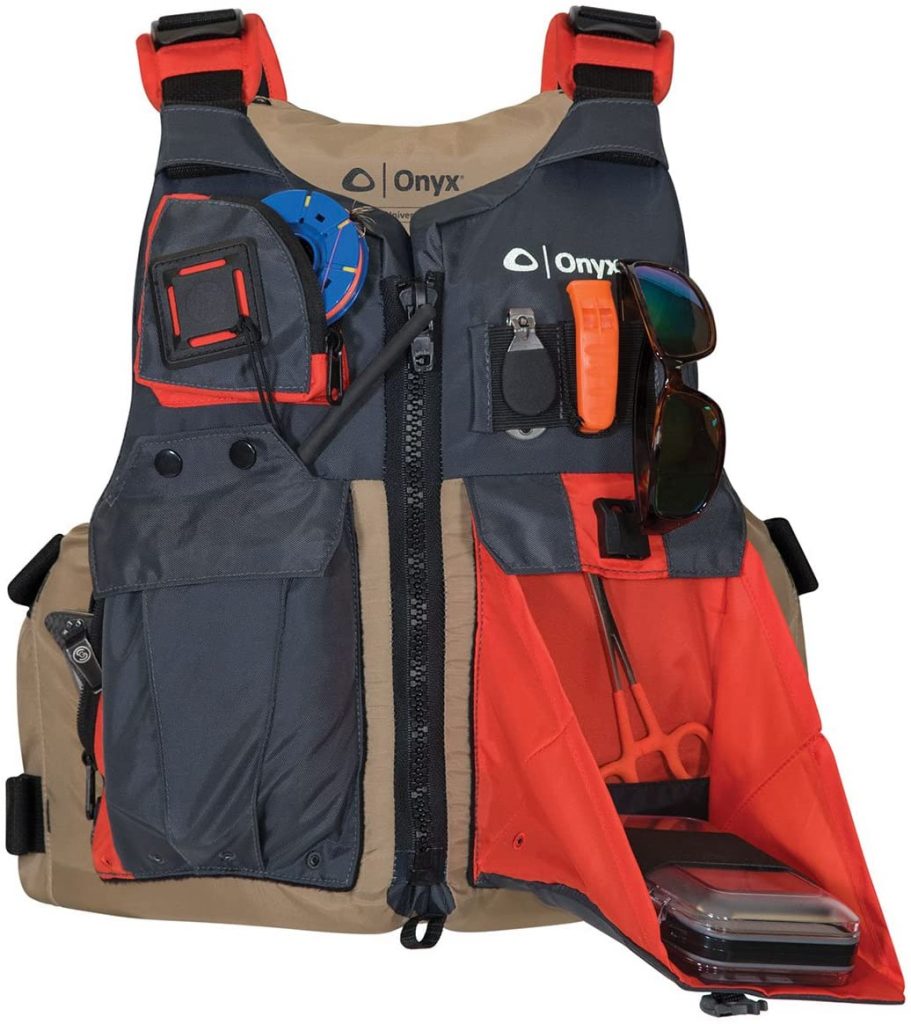
If you’re on a budget, I highly suggest that you consider the Onyx Kayak Fishing Life Jacket. This is made with high-back foam so you can sit comfortably on almost any kayak chair.
Aside from that, this has breathable mesh material on the lower back to keep you cool. This is paired with neoprene shoulder pads for warmth and comfort.
Moreover, this life jacket has six adjustment straps to achieve the fit you need. It also has a durable main zipper in front, so it’s very easy to put on and off.
The highlight of this life jacket is its storage pockets. It has a collapsible pocket that you can use as a tiny table for your tackle. It also has a tool holder, spool holder, and other attachment points for your convenience.
However, this life jacket is only available in two sizes: universal and oversize. Nevertheless, most anglers will find any of these two fittings with the right adjustments.
This is USCG-approved, but not for inclement weather or strong currents. For this price range and quality, this is already a steal. I noticed some minor niggles, but it’s something I can work with.
How to choose a lightweight life vest for fishing
To find the best lightweight life vest for fishing, it’s important to consider the following points:
✔️USCG classification
The very first thing you should check is the US Coast Guard classification or certification of the persona floatation device (PFD). This is very important, especially if you’re planning to fish on open seas or a large boat.
The following are the USCG classifications and their meaning:
- Type I PFD. This life vest is made with 22 lbs. of foam floatation. It’s suitable for commercial use with a reversible design. It will turn unconscious wearers face-up in the water.
- Type II PFD. This is a near-shore life vest with 15.5 lbs. of floatation. It’s meant for use on calm waters or inland in case you need to perform a quick rescue.
- Type III PFD. It’s also called floatation aid with 15.5 lbs. of floatation. As the Type II PFD, this is ideal for calm waters only. Still, it will put your face up in case you lose consciousness in the water.
The Type IV and Type V PFDs aren’t usually wearables and used as additional floatation aids in water only.
So which one do you need for fishing? The farther you go from the shore, the more you have to invest in Type I PFD.
✔️Material
Life jackets are often made from a blend of nylon, polyester, foam, and neoprene. Nylon is a widely used floatation device material because it doesn’t trap water like other fabrics. Also, it’s lightweight and very affordable.
On the other hand, polyester is often used in the interior portion to wrap the foam or reinforcements. Overall, it’s rarely the main material.
Lastly, neoprene is used for the straps and backing to give wearers added comfort. It also keeps the life jacket snug while on water.
✔️Storage options
Storage options are very important when buying life jackets. There should be at least one large pocket where you can place fishing items like spools, small tackle box, and so on. Aside from that, there should be a tool holder for your fishing pliers, sunglasses, and additional tackle.
Lastly, make sure that there are multiple tabs and loops all over the life jacket. You can attach a carabiner to it so you can carry more items. However, you should never overload a life jacket, or it will affect your buoyancy.
✔️Size and fit
The size and fit of the life jacket are very important because it will affect your safety. Make sure that the vest is snug and not too loose. This should keep the jacket in place even as you get swept by strong currents.
The good thing is that life jackets are widely adjustable. Unless you’re on the unusually large size, most life jackets in the market with standard fits will suit you well.
✔️Reflective accents
I always look for reflective accents when shopping for a lightweight life vest for fishing. Sometimes, our fishing trips won’t always go as planned, and we end up being in the water as the sun goes down. In these situations, the reflective accents will keep us visible in the water as we try to reach the shore.
Frequently Asked Questions
Q: How long does an inflatable fishing jacket last?
A: These jackets can last for up to 10 years. But unlike foam types, it’s very prone to punctures and damages. Also, if the inflatable air chambers deflate while you’re on the water, it will spell trouble. If you’re always going to offshore fishing trips, I suggest investing in Type I Coast Guard-approved life jackets instead.
Q: Can you drown with a life jacket on?
A: Yes, it’s still possible to drown with a life jacket on if you’re caught in the middle of a storm on the sea. But before this happens, it requires large waves and extremely rough conditions. But if you fell on a placid lake or river, there’s a very low risk that you’re going to drown. This is unless you lost consciousness and fell facedown.
Q: Is it required to wear life jackets while fishing?
A: Some areas and reservoirs have strict rules about wearing life jackets when fishing offshore. It’s important to check the rules of the fishing reservoir as well as your locality when it comes to the use of life jackets. But regardless if there’s a rule or not, there’s nothing to lose if you’re going to wear one. It will even give you added peace of mind and convenience.
Q: Do you need to have a life jacket on a kayak?
A: The US Coast Guard imposes rules on putting wearable life jackets on vessels. The ratio is 1:1 for the capacity of the vessel. Unlike large boats, kayak owners aren’t required to bring a throwable device and other buoyant aids due to the smaller cockpit capacity.
Q: Can I wear a typical life jacket for fishing?
A: Yes, you can wear one of those typical floatation devices they give you on boat rides. But unlike those made for fishing, these life jackets don’t have pockets where you can keep tackle. Also, the Coast Guard certification will vary widely.
Final words
Life jackets are a must, even for anglers. A lightweight life vest for fishing will give an added layer of protection while you enjoy the storage pockets’ convenience. Just make sure that you get one with the suitable USCG classification as well as material, size, and features.

